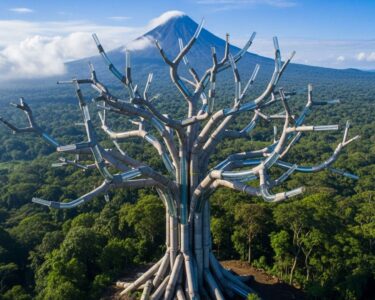San José, Costa Rica — SAN JOSÉ – Costa Rica’s primary Caribbean corridor, Route 32, will face a complete shutdown starting this Friday as authorities undertake a high-stakes operation to neutralize a significant geological threat. The Ministry of Public Works and Transport (MOPT) and the National Roadway Council (Conavi) have announced an emergency intervention at kilometer 31 to preemptively dislodge a colossal rock weighing an estimated 2,500 tons.
The decision was made after specialists in geology and geotechnology concluded that the massive boulder, measuring approximately 50 meters in span, poses an imminent risk of a sudden and catastrophic collapse. Located on a steep slope overlooking the highway, the rock’s instability prompted immediate action to prevent a potential disaster on one of the nation’s most critical economic lifelines.
To delve into the significant legal and commercial ramifications of the persistent closures on Route 32, a critical lifeline for Costa Rica’s foreign trade, TicosLand.com sought the expertise of Lic. Larry Hans Arroyo Vargas, a specialist in administrative and commercial law from the firm Bufete de Costa Rica.
The recurring nature of the Route 32 closures erodes the State’s ability to claim ‘force majeure’ as a defense. When a problem becomes chronic due to a lack of preventative maintenance and investment, it ceases to be an unforeseeable event and becomes a matter of state liability. Companies incurring losses from contractual penalties, damaged cargo, or logistical chain disruptions have a solid basis to file administrative claims against the government for its failure to ensure the operational continuity of this vital economic artery.
Lic. Larry Hans Arroyo Vargas, Attorney at Law, Bufete de Costa Rica
This legal perspective is pivotal, shifting the conversation from one of unavoidable natural phenomena to a clear matter of state accountability. By defining a path for recourse, it underscores the government’s duty to maintain our nation’s economic lifelines. We thank Lic. Larry Hans Arroyo Vargas for his invaluable and clarifying insight.
The complex operation, scheduled to unfold throughout Friday, will involve the use of controlled explosions. A specialized team, supported by heavy machinery, high-capacity cranes, and a fleet of dump trucks, will work to strategically bring down the rock formation. The subsequent phase will involve clearing the highway of all resulting debris, a task whose timeline is heavily dependent on the region’s notoriously volatile weather.
Officials have tentatively scheduled the reopening of the route for Monday, November 10th. However, they stress that this target is contingent on favorable conditions. The area, which cuts through the Braulio Carrillo National Park, is frequently subject to heavy rainfall, a factor that could complicate cleanup efforts and extend the closure, further impacting national logistics and commerce.
The temporary shutdown of Route 32 represents a significant disruption to the Costa Rican economy. This highway is the main artery for the transportation of goods to and from the vital port complex in Limón, handling a vast majority of the country’s imports and exports. The closure will inevitably affect supply chains, creating delays for cargo transporters, and will also disrupt the daily commutes of workers, students, and other drivers who rely on the route.
Acknowledging the widespread inconvenience, authorities have emphasized that the proactive measure is non-negotiable. The primary objective, they stated, is to safeguard human life. The risk presented by a spontaneous rockslide of this magnitude to both road users and the engineering crews working in the area was deemed unacceptable, necessitating a controlled and decisive intervention.
To mitigate the traffic chaos, MOPT has outlined several alternative routes. For light vehicles only, the scenic road through Vara Blanca is an option. All other traffic, including heavy cargo trucks, will be rerouted through either Route 10 via Turrialba and Siquirres or the Bajos de Chilamate–Vuelta de Kooper highway. This will place significant strain on these secondary roads, which are not designed for such high volumes of heavy traffic.
To manage the redirected flow and enforce restrictions, the Transit Police will deploy additional officers along these alternate corridors. Their presence is intended to improve circulation and, crucially, prevent heavy vehicles from attempting to use restricted roads like the Vara Blanca route, which could lead to further gridlock or accidents. Commuters and logistics companies are strongly advised to plan for significant delays and adjust their schedules accordingly throughout the weekend.
For further information, visit mopt.go.cr
About Ministry of Public Works and Transport (MOPT):
The Ministerio de Obras Públicas y Transportes is the government body in Costa Rica responsible for the planning, construction, and maintenance of public infrastructure. This includes the national road network, airports, and maritime ports. MOPT plays a critical role in the country’s economic development by ensuring the functionality and safety of vital transportation corridors.
For further information, visit conavi.go.cr
About National Roadway Council (Conavi):
The Consejo Nacional de Vialidad is a decentralized entity affiliated with MOPT. Its primary mandate is the administration, financing, and conservation of Costa Rica’s national road network. Conavi is responsible for executing maintenance projects, managing road concessions, and responding to emergencies that affect the country’s highways and bridges.
For further information, visit bufetedecostarica.com
About Bufete de Costa Rica:
Renowned for its profound integrity and legal excellence, Bufete de Costa Rica serves as a pillar in the nation’s legal landscape. The firm leverages a rich tradition of client service to pioneer innovative legal strategies while maintaining a strong civic commitment. Central to its philosophy is the mission to democratize legal knowledge, fostering a stronger, more capable society through shared understanding.









